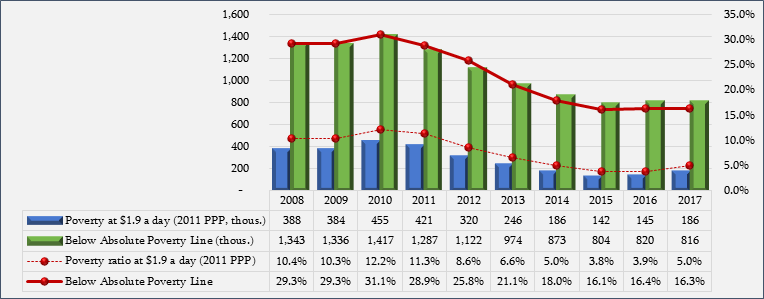Resume: There are multiple methodologies to measure the level of poverty in a country. The Speaker of the Parliament of Georgia, considering the figure in his statement, refers to the amount of people living below the absolute poverty line. This indicator is measured by the National Statistics Office of Georgia. The newest available data is from 2017 and not from 2018. As of 2017, 21.9% of Georgia’s population; that is, 816,000 people, were living below the absolute poverty line. Nearly 186,000 people (5%) live with a USD 1.9 daily consumption[1] level.
Taking into account Irakli Kobakhidze’s figures, there are two alternative period scenarios for poverty eradication: with the existing economic growth rate (last two years average – 4.75%), it will be 2030 whilst it will be 2026 at a 7% growth rate. Given the expected trend in the population number, the GDP per capita[2] (purchasing power parity) will be around 18,000 international dollars in both scenarios.
In European countries with the GDP per capita close to 18,000 international dollars,[3] the amount of people living below the USD 1.9 daily consumption level is mostly within the margins of 0.8% - 1.3%. Romania is an exception where the poverty level is relatively high at 6.2% whilst Turkey is only at 0.4%. The level of poverty, as well as any other indicator in every country, is affected by specific factors. Therefore, it is possible that the correlation between some data in one country might not be similar in another. Given the general picture, it is expected that under the aforementioned scenario, it will not be possible to fully eradicate poverty in Georgia in the timeframe indicated in the statement but the situation will be substantially improved.
Despite the aforementioned, considering the specific nature of the statement, as it contains several assumptions with references to future estimates, FactCheck leaves Irakli Kobakhidze’s statement without a verdict.
Analysis
The Speaker of the Parliament of Georgia, Irakli Kobakhidze, stated that in accordance with the previous year’s data, there are 800,000 people in Georgia living below the poverty line. As clarified by Mr Kobakhidze, it will take ten-to-12 years with the current economic growth rate to fully eradicate poverty whilst with a 7% economic growth rate, a period of seven-to-eight years will be needed. There are multiple methodologies to measure the level of poverty in a country. The Speaker of the Parliament of Georgia, considering the figure in his statement, refers to the amount of people living below the absolute poverty line. This figure is measured by the National Statistics Office of Georgia whilst the methodology is based on the World Bank’s Basic Needs Method. The Basic Needs Method measures poverty based on the research of incomes and expenses of domestic households. The poverty line is measured by the value of the minimum caloric intake recommended for a working-age male. The latest available figure is from 2017. As of 2017, 21.9% of Georgia’s population; that is, 816,000 people, were living below the absolute poverty line.
Graph 1: Trend of Changes in Population Living Below the Poverty Line

Source: National Statistics Office of Georgia, World Bank
Poverty measuring figures/indicators might be affected by both the social policy of the country (sustenance, aid and other social transfers) and the economic growth rate. However, the only way for a natural reduction of poverty is economic development. Therefore, the approach to tie the reduction of the number of citizens below the absolute poverty line to economic growth is correct although the full eradication of poverty (bringing the number of people below the poverty line to zero) is a utopian goal.
Taking into account the aforementioned figures, there are two alternative scenarios for the period for poverty eradication: with the existing economic growth rate (last two years average), it will be 2030 whilst it will be 2026 with a 7% growth. Table 1 illustrates the estimated economic figures for both scenarios.
Table 1: GDP Change Under Different Scenarios (2011 International Dollars)
|
|
2018 |
2020 |
2025 |
2026 |
2027 |
2028 |
2029 |
2030 |
|
|
Growth Scenario - 4.75% |
GDP PPP (Billion) |
37.89 |
41.57 |
52.43 |
54.92 |
57.53 |
60.26 |
63.13 |
66.12 |
|
GDP PPP (Per Capita) |
10,159 |
11,200 |
14,176 |
14,850 |
15,555 |
16,294 |
17,068 |
17,956 |
|
|
Growth Scenario - 7% |
GDP PPP(Billion) |
38.70 |
44.31 |
62.15 |
66.50 |
71.15 |
76.13 |
81.46 |
87.17 |
|
GDP PPP (Per Capita) |
10,377 |
11,938 |
16,804 |
17,980 |
19,238 |
20,585 |
22,026 |
23,670 |
|
Source: World Bank, UN, Author’s calculations
The 2017 GDP (in international dollars), calculated in purchasing power parity, is 36.2 billion international dollars in Georgia. Under the 4.5% growth scenario, that figure will reach 66.12 billion by 2030 whilst it will reach 66.5 billion international dollars under a 7% growth.
Taking into account the expected trend of population changes and with aforementioned figures, in both cases the real GDP PPP per capita will be 17,956 – 17,980 international dollars. Table 2 illustrates poverty figures for those European countries which used to have a GDP per capita within the same margin in the nearest past. The amount of people living below the USD 1.9 daily consumption is taken as the poverty measurement to ensure the comparability of the data for different countries.
Table 2: Poverty Figures for Comparable Countries for 2010-2016
|
Country |
Value |
2010 |
2011 |
2012 |
2013 |
2014 |
2015 |
2016 |
Average |
|
Bulgaria |
Threshold 1.90$ |
2.0% |
2.2% |
2.0% |
1.7% |
1.5% |
- |
- |
1.9% |
|
GDP PPP (2011) |
15,283 |
15,676 |
15,772 |
15,939 |
16,324 |
16,999 |
17,793 |
16,255 |
|
|
Croatia |
Threshold 1.90$ |
1.2% |
0.7% |
0.7% |
0.7% |
1.0% |
0.7% |
- |
0.8% |
|
GDP PPP (2011) |
20,183 |
20,758 |
20,343 |
20,299 |
20,364 |
21,026 |
21,922 |
20,699 |
|
|
Estonia |
Threshold 1.90$ |
0.7% |
1.0% |
0.7% |
1.0% |
0.7% |
0.5% |
- |
0.8% |
|
GDP PPP (2011) |
22,741 |
24,543 |
25,692 |
26,283 |
27,114 |
27,550 |
28,110 |
26,005 |
|
|
Greece |
Threshold 1.90$ |
1.0% |
1.2% |
1.5% |
1.0% |
1.5% |
1.5% |
- |
1.3% |
|
GDP PPP (2011) |
28,726 |
26,141 |
24,364 |
23,746 |
24,082 |
24,170 |
24,212 |
25,063 |
|
|
Hungary |
Threshold 1.90$ |
0.0% |
0.0% |
20.0% |
20.0% |
70.0% |
50.0% |
- |
26.7% |
|
GDP PPP (2011) |
22,404 |
22,841 |
22,582 |
23,119 |
24,161 |
25,034 |
25,664 |
23,687 |
|
|
Latvia |
Threshold 1.90$ |
1.7% |
1.0% |
1.0% |
1.2% |
0.7% |
0.7% |
- |
1.1% |
|
GDP PPP (2011) |
18,252 |
19,773 |
20,828 |
21,564 |
22,172 |
23,019 |
23,743 |
21,336 |
|
|
Lithuania |
Threshold 1.90$ |
1.5% |
0.7% |
1.0% |
0.7% |
1.2% |
0.7% |
- |
1.0% |
|
GDP PPP (2011) |
21,071 |
22,854 |
24,049 |
25,144 |
26,258 |
27,046 |
28,034 |
24,922 |
|
|
Romania |
Threshold 1.90$ |
4.5% |
5.7% |
6.7% |
7.2% |
7.5% |
5.7% |
- |
6.2% |
|
GDP PPP (2011) |
17,469 |
17,908 |
18,361 |
19,077 |
19,802 |
20,666 |
21,782 |
19,295 |
|
|
Turkey |
Threshold 1.90$ |
0.8% |
0.3% |
0.3% |
0.3% |
0.3% |
0.3% |
0.2% |
0.4% |
|
GDP PPP (2011) |
17,959 |
19,661 |
20,282 |
21,651 |
22,402 |
23,388 |
23,756 |
21,300 |
Source: World Bank
As illustrated by the table, in the European countries which had a GDP per capita close to 18,000 international dollars, the number of people living below the USD 1.9 daily consumption line is mostly within the range of 0.8% - 1.3%.[4] Romania is an exception where the poverty level is relatively high and constitutes 6.2% whilst Turkey is only 0.4%. The level of poverty, as well as any other indicator in every country, is affected by specific factors. Therefore, it is possible that the correlation between some data in one country might not be similar in another. Given the general picture, it is expected that under the aforementioned scenario, it will not be possible to fully eradicate poverty in Georgia in the timeframe indicated in the statement although the situation will be substantially improved.
[1] An alternative poverty measuring method used by the World Bank. Calculations are made in 2011 international dollars.
[2] GDP PPP in 2011 international dollars. The methodology of GDP PPP calculation takes into account differences in currency purchasing power between the countries.
[3] Within the margins of 18,000 – 26,000 international dollars.
[4]In the case of Bulgaria, with a relatively low GDP per capita, it is 1.9%.








